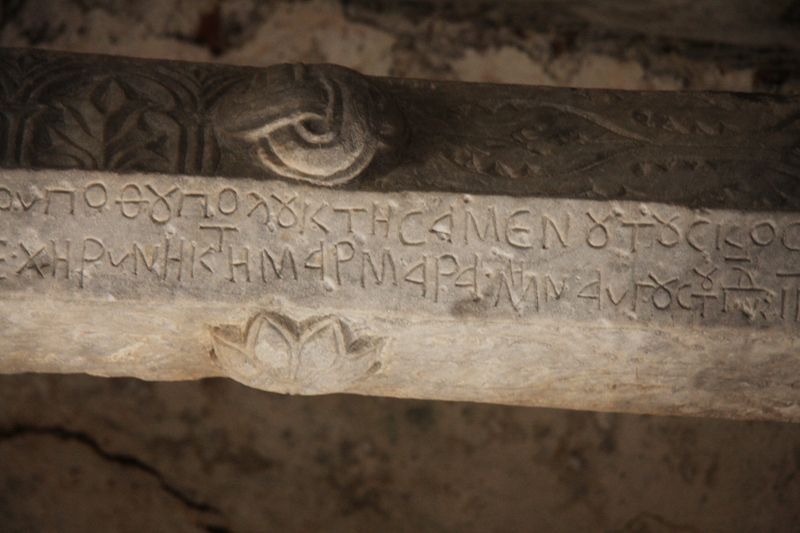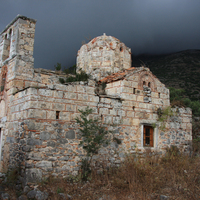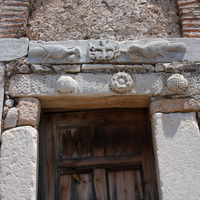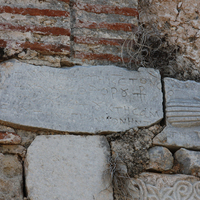Hagioi Theodoroi in Vamvaka
Type:
Churches,
Monasteries,
Wall paintings
Date:
1075
Location or Findspot (Modern-Day Country):
Greece
Description:
The village of Vamvaka in the Mani (southern Greece) has multiple Byzantine churches, but only one retains its medieval form despite its precarious state of preservation today. This stone-and-brick church is dedicated to the two military saints named Theodore. One of them, on horseback, is still partly visible in a thirteenth- or fourteenth-century fresco layer mostly hidden by whitewash.
Above the portal, carved peacocks bite grapes that emerge from a cross; all are symbols of the Eucharist and salvation. The Greek inscription to the left asks God to remember Theodore the priest and his wife, Kale, who built "this holy monastery."
Inside, the marble beams that connect the four piers supporting the dome are carved with stylized vegetal motifs under an arcade divided by projecting knots. An inscription under the western beam gives additional information. It says: "Remember, Lord, your servant Leo, with his wife and children, who with great devotion had these beams carved. Chanters, pray for him. Amen, so be it, Lord. They were made by the hand of the marble sculptor Niketas, in the month of August, thirteenth indiction [a fifteen-year tax period], year 6583." This Byzantine year is equivalent to 1075 CE, and the carver Niketas is attested at four other churches in the region. The unusual injunction to the chanters reminds us about the sounds that once filled the church.
The multiple injunctions to "remember" are also underscored by the reuse of ancient tombstones in the church walls, the presence of a surrounding cemetery, and graffiti that record important events (e.g., "In the year 1537/8 the Turks plundered the Mani"). Hagioi Theodoroi is still the locus of memory for the Vamvaka villagers, many of them named Theodore.
Above the portal, carved peacocks bite grapes that emerge from a cross; all are symbols of the Eucharist and salvation. The Greek inscription to the left asks God to remember Theodore the priest and his wife, Kale, who built "this holy monastery."
Inside, the marble beams that connect the four piers supporting the dome are carved with stylized vegetal motifs under an arcade divided by projecting knots. An inscription under the western beam gives additional information. It says: "Remember, Lord, your servant Leo, with his wife and children, who with great devotion had these beams carved. Chanters, pray for him. Amen, so be it, Lord. They were made by the hand of the marble sculptor Niketas, in the month of August, thirteenth indiction [a fifteen-year tax period], year 6583." This Byzantine year is equivalent to 1075 CE, and the carver Niketas is attested at four other churches in the region. The unusual injunction to the chanters reminds us about the sounds that once filled the church.
The multiple injunctions to "remember" are also underscored by the reuse of ancient tombstones in the church walls, the presence of a surrounding cemetery, and graffiti that record important events (e.g., "In the year 1537/8 the Turks plundered the Mani"). Hagioi Theodoroi is still the locus of memory for the Vamvaka villagers, many of them named Theodore.
Relevant Textbook Chapter(s):
7
Repository and Online Resources:
• Watch a 15-minute film, "Blessings and Vows" (2018), about the church at Vamvaka and the villagers invested in its preservation.
Image Credits:
Sharon E. J. Gerstel; used by permission




